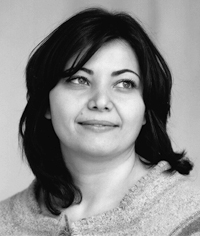Mina Kirkova, MA, MSW, LCSW-C
Counseling and Therapy for Children, Adolescents, & Adults
in Phoenix/Jacksonville, Maryland
3009 Jackson Ridge Ct. Phoenix, MD, 21131
minakirkova@gmail.com
(443) 322-6552
ADD/ADHD, Anxiety, Stress, Mindfulness, Meditation, School Underachievement, Organizational Skills, Time Mngt., Phobias, Grief, Loss, Depression, Emotional Dysregulation, Self-Confidence, Bullying, Social Skills, Assertiveness, Sibling Rivalry, Disciplining Issues, Anger, Arguing, Rebelliousness , Lying
MY SPECIALTIES



MY APPROACH TO ADOLESCENT THERAPY
The success of my therapeutic approach is based on a combination of individual adolescent therapy and family therapy. In order to achieve lasting changes in any adolescent’s behavior, I encourage active parental involvement in our therapy sessions. As an adolescent therapist, I meet regularly with parents to share my clinical observations, learn more about the adolescent's life at home and in school, and offer suggestions how parents can support their adolescent’s progress in therapy. A crucial piece of my therapeutic approach with adolescents includes working on their values, belief systems, and philosophical explorations of existential questions. Behavior contract drafting is another technique I use on a regular basis in my work with parents of teenagers exhibiting oppositional defiant behaviors (anger, rebelliousness, manipulation, lying, resentfulness, disciplining issues). Other issues commonly addressed in my sessions with adolescents are:
- Dating, sexuality and intimacy, gender identity questioning
- Drug and alcohol use, negative peer influences
- School grades, college applications, college decision making, time management and organizational skills
- Unhealthy sleeping or eating patterns, daily exercise, technology, social media, electronic devices overuse
Performance Anxiety Counseling for Athletes, Musicians, Artists, and Highly Achieving Students
I offer counseling to gifted and talented adolescents who are struggling with the following issues:
- Fear of judgment from authority figures, fear of making mistakes or failing
- Depression, low motivation, panic attacks, perfectionist tendencies
- Low self-esteem, lack of confidence and self-trust while performing under pressure
- Negative psychological effects from sports injuries
- Inability to return to a previous level of performance or to improve current performance
- Self-defeating thoughts and feelings resulting in negative behaviors or impeding performance
MY APPROACH TO FAMILY THERAPY
Family therapy is an essential part of my work with adolescents and their parents. In family therapy, I meet with the parents and their teens together in order to solve differences between them and discuss difficulties parents may have at home with their teens, usually related to: daily chores, overuse of electronic devices/video games, unhealthy eating or sleeping patterns, exercise, friends, homework, school grades, etc.
In addition, I often see parents in individual and family therapy sessions without their children being present in order to discuss difficulties and stressors the parents might have in their own relationship which could be also affecting their children in a negative way. Such issues may include: communication problems, financial issues, mismatched expectations, inability to compromise, religious differences, dealing with in-laws, and differences in values and beliefs. My family therapy sessions also help spouses discuss differences in their parenting styles, which often stem from the way their own parents raised them. Discussing parenting style differences helps to clarify and solidify the couple’s current parental approach in order to provide their adolescent with a positive and consistent home structure.
In order to achieve quick and lasting results with adolescents and their families, I draw on a variety of therapeutic techniques and modalities listed below.
COGNITIVE-BEHAVIOR THERAPY (CBT)
Cognitive-behavior therapy relies largely on verbal learning principles—namely, those that involve cognition (perception, thinking, reasoning, attention, and judgment). The basic cognitive-behavior strategy is to change the thoughts, beliefs, assumptions, and attitudes that are contributing to the adolescent’s emotional or behavioral problems. In other words, when working from a cognitive-behavior viewpoint in adolescent therapy, I aim toward changing distorted thinking patterns in order to change the way an adolescent feels and behaves. Cognitive-behavior techniques are powerful tools in the hands of a skilled adolescent therapist. I have found them particularly helpful in the treatment of phobias, panic attacks, anxiety issues, depression, low self-esteem, etc.
- learn more
SOLUTION-FOCUSED THERAPY
Solution-focused therapy emphasizes the construction of solutions to problems, rather than an examination of their causes or how they are maintained. This approach rests on the belief that adolescents can solve their problems by doing more of what has been successful for them in the past. When using solution-focused techniques in adolescent therapy, I help teenagers notice when their troubling symptoms decrease and use this as a basis for recovery. In my experience as an adolescent therapist, solution-focused techniques have proven helpful in the treatment of peer pressure, bullying, stress management, anxiety, etc.
- learn more
MINDFULNESS, MEDITATION, AND RELAXATION TECHNIQUES
Mindfulness, Meditation, and Relaxation Techniques help adolescents to:
- Become ore aware of their body, thoughts, and surrounding environment
- Get in touch with their inner core and strengthen it
- Improve their self esteem and confidence
- Slow down and think before speaking or acting
- Stay grounded in reality, eliminate “catastrophic/worst case scenario thinking”
GUIDED WELLNESS IMAGERY AND VISUALIZATIONS
Guided wellness imagery and visualizations entails a variety of relaxation techniques in adolescent therapy aiming toward tension release and attainment of a peaceful, balanced, and focused state. As an adolescent therapist, I help teenagers achieve such states by visualizing relaxing images and situations, such as a beautiful beach, a green meadow, or a sparkling waterfall. Such relaxed states may decrease stress, promote physical, emotional, and spiritual healing, as well as improve performance and release creativity blocks.
- lean more
YOGA, MOVEMENT, AND BREATHING PRACTICES
Yoga, movement, and breathing practices help adolescents to:
- Get in touch with their inner core and strengthen it
- Deal with difficult feelings by expressing them through movement or letting go of them through their breath
- Learn and practice breathing techniques to calm and center their body and mind
ART THERAPY
In art therapy, adolescents use clay, paint, and other art mediums to create images that symbolically explore their feelings, dreams, fears, fantasies, memories, ideas, and subconscious defenses. As an adolescent therapist, I use art therapy techniques to assist teenagers increase their insight and judgment, cope with stress, work through traumatic experiences, and strengthen relationships with family and friends.
In my experience as an adolescent therapist, art therapy techniques have been particularly applicable in the treatment of adolescents experiencing difficulties with divorce, adoption, bereavement, school transitions, socialization, ADD/ADHD, sibling rivalry, low self-esteem, and bullying. Art therapy techniques have proven successful also in the treatment of depression, anxiety, trauma, eating disorders, phobias, panic attacks, peer pressure, etc.
NARRATIVE THERAPY
As an adolescent therapist, I employ narrative therapy techniques to help teenagers externalize problems rather than focus on problems as being part of themselves. This process of “externalization” allows adolescents to consider new relationships with problems based on the motto “The person is not the problem, the problem is the problem.” Through the use of narrative therapy techniques, I help adolescents in therapy create changes by discovering different, more productive, realistic, and satisfying stories about their lives.




